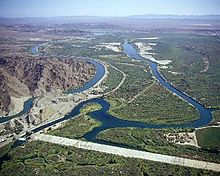Laguna Dam
| Laguna Diversion Dam | |
|---|---|

Overhead of dam facing north
|
|
|
Location of Laguna Diversion Dam in USA California
|
|
| Location | Imperial County, California / Yuma County, Arizona, USA |
| Coordinates | 32°49′23″N 114°29′39″W / 32.82306°N 114.49417°WCoordinates: 32°49′23″N 114°29′39″W / 32.82306°N 114.49417°W |
| Construction began | 1903 |
| Opening date | 1905 |
| Operator(s) | U.S. Bureau of Reclamation |
| Dam and spillways | |
| Type of dam | Rock-fill weir, concrete surface |
| Impounds | Colorado River |
| Height | 43 feet (13 m) |
| Length | 4,780 feet (1,460 m) |
| Spillway type | Controlled service |
The Laguna Diversion Dam is a rock-filled diversion dam on the Colorado River. It is located 13 miles northeast of Winterhaven, CA–Yuma, AZ on Imperial County route S24. Constructed between 1903 and 1905, the dam was the first dam built on the Colorado River and subsequently ended boat travel to the north.
After the passage of the Reclamation Act by the US Congress in 1902, the U.S. Bureau of Reclamation began constructing the dam under the Yuma Project in 1903. This project was the first development of the U.S. Reclamation Service along the Lower Colorado River and featured the Laguna Diversion Dam, a pumping station and a series of canals. On July 6, 1905 the contract to build the dam was awarded to J. G. White and Company who started construction less than two weeks later. Deliveries of cement were a problem as they had to be delivered to Yuma by rail and to the construction site by wagons or steamboat. Poor rock quality at local quarries also posed a problem that consistently delayed construction, 50% of the weak rock was unusable. Even after their contract was supplemented to encompass the rock quality delays, J. G. White and Company still did not meet their deadline and the Bureau of Reclamation took over construction in early 1907.
To solve the cement delivery problems, the Bureau of Reclamation had built a levee on the California side on the dam that was topped by a rail-line by March 1908. Beforehand, they had also gained the cooperation of the Southern Pacific Railroad who agreed to deliver cement directly at the dam site. The rock problem was solved when the Bureau raised the upstream and downstream cofferdams with rock waste and topped them with rail lines that could deliver rock-fill much faster. By December 1908, the water bypass around the dam was complete and workers began to pour the rock-fill. Three large concrete walls supported by 6-inch sheet-wood pilings were built across the river for the dam's foundation. Rock-fill was placed in between and on the outsides of these walls for support. The California sluiceway consisted of three iron gates while the Arizona had one. Mexican-Americans mostly worked on the dam while a few Native American Indians did as well. Skilled white-labor worked in the cooler months.
...
Wikipedia

